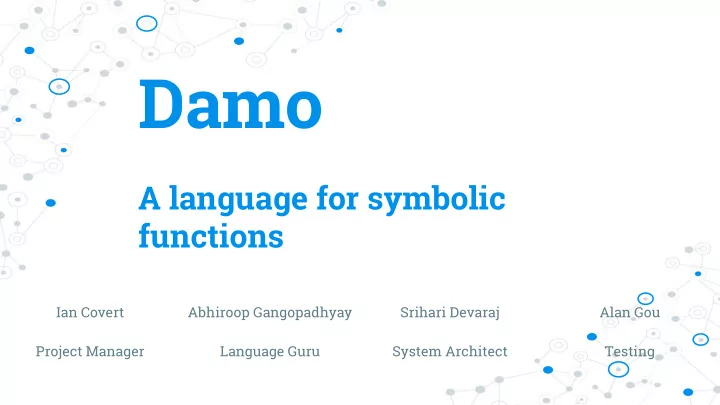

Damo A language for symbolic functions Ian Covert Abhiroop Gangopadhyay Srihari Devaraj Alan Gou Project Manager Language Guru System Architect Testing
I. Introduction Why...
CORE FEATURES ● Scripting language ● Symbolic expressions ● Standard library for symbolic function evaluation, automatic differentiation
MOTIVATION ● Ease of development for applications requiring automatic differentiation ● Useful for many kinds of machine learning, such as SGD algorithm for neural networks ● Historical note: Damo was child of Theano – a popular Python deep learning ○ library
II. Project Management Responsibilities, lessons learned
EVERYONE BECOMES A DEVELOPER Abhiroop Built SAST, semantic checking and tests Ian Implemented parser, standard library and tests Hari Implemented codegen and tests Alan Took the worst classes of his life this semester
LESSONS LEARNED ● Iterative development makes life easier ● Specialization is helpful, but dangerous ● Realistic deadlines are necessary ● Never assume that something works
III. The Damo Language Speaking our dialect
SYNTAX BASICS // Single line comment /* OPERATORS /* + - * / ^ _ % Multiline and or not comment < > <= >= == != */ TYPES int // VARIABLE DECLARATION num int i; bool int j = 1; string symbol */
SIMPLE PROGRAMS print(“Hello world”); num a; num b; // FUNCTION DECLARATION num c; def sayHello(string name) : void { print(“Hello, “); a = 1; print(name); b = 2.0; } c = a * b; sayHello(“Stephen”); print_num(c);
CONTROL FLOW // C-like loops // C-like if-elseif-else statements int i; if (i < 0){ print(“i less than 0”); print(“Going up”); } for (i = 0; i < 10; i = i + 1){ elseif (i < 10){ print_int(i); print(“i less than 10”); } } else { print(“Going down”); print(“i greater than 10”); while (i > 0){ } print_int(i); i = i - 1; }
SYMBOLIC EXPRESSIONS // Declare symbols // DEPENDENCY GRAPH symbol a; a symbol b; * symbol c; // Set symbolic expression + – a = b + c; a = a * (b - c); // Set symbols to constant values b = 4; b = 4 c = 5 c = 5;
THE STANDARD LIBRARY // Function evaluation symbol a; symbol b; symbol c; a = b * c; b = 4; c = 5; num result = eval(a); num deriv = partialDerivative(a, b);
IV. How it works Implementation details
OUR COMPILATION PIPELINE Source code Program written in Damo Linked with Standard library prepended stdlib Symbols Scanner AST Parser SAST Semantic checking LLVM Codegen Executable C compiler: links with C code
ABSTRACT SYNTAX TREE ● A Damo program is a list of variable declarations, function declarations, and statements ● Arbitrary ordering ● Semantic checking verifies proper usage of variables and functions
HEAP ALLOCATED SYMBOLS ● Invoke C functions to allocate heap memory symbol_malloc = Llvm.declare_function “createSymbol” (Llvm.function_type symbol_t [| |] the_module ... A.Symbol -> let global_variable = L.build_call symbol_malloc [| |] “symbolmal” builder in ignore(L.build_store global_variable s_v builder);
THE SYMBOL STRUCT ● Underlying C struct represents symbol type struct symbol { symbol *left; symbol *right; int isConstant; int isInitialized; double value; };
LINKING WITH C CODE ● Makefile builds symbol.c, a library we wrote to handle routines relating to symbols Heap memory allocation ○ Accessor, mutator functions ○ ● Damo executables are linked with C standard library, and symbol.o
V. Testing It works, we promise
UNIT AND INTEGRATION TESTS ● We tested for every feature of the Damo language Operators ○ Functions ○ Global variables ○ Standard library functions ○ Etc. ○
THE ULTIMATE TEST ● Showing off in our demo – a big integration test
Let’s demo it!
Recommend
More recommend